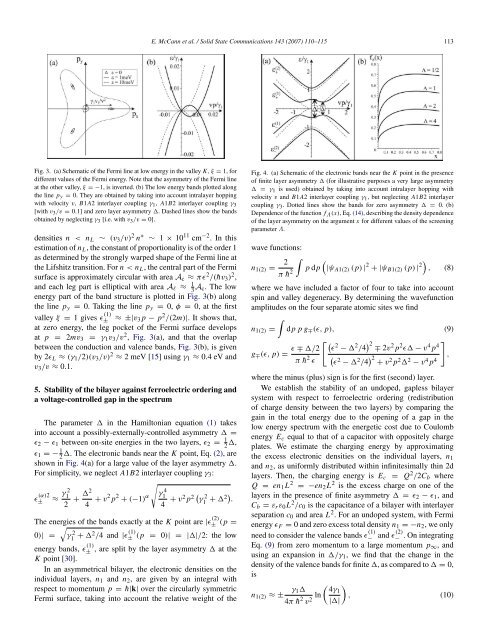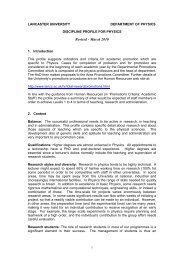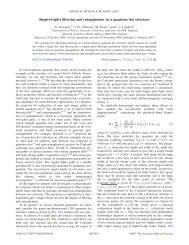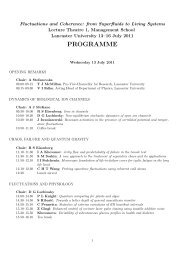E. McCann et al. / Solid St<strong>at</strong>e Communic<strong>at</strong>ions 143 (2007) 110–115 113Fig. 3. (a) Schem<strong>at</strong>ic of the Fermi l<strong>in</strong>e <strong>at</strong> low energy <strong>in</strong> the valley K, ξ = 1, fordifferent values of the Fermi energy. Note th<strong>at</strong> the asymmetry of the Fermi l<strong>in</strong>e<strong>at</strong> the other valley, ξ = −1, is <strong>in</strong>verted. (b) The low energy bands plotted alongthe l<strong>in</strong>e p y = 0. They are obta<strong>in</strong>ed by tak<strong>in</strong>g <strong>in</strong>to account <strong>in</strong>tralayer hopp<strong>in</strong>gwith velocity v, B1A2 <strong>in</strong>terlayer coupl<strong>in</strong>g γ 1 , A1B2 <strong>in</strong>terlayer coupl<strong>in</strong>g γ 3[with v 3 /v = 0.1] and zero layer asymmetry . Dashed l<strong>in</strong>es show the bandsobta<strong>in</strong>ed by neglect<strong>in</strong>g γ 3 [i.e. with v 3 /v = 0].densities n < n L ∼ (v 3 /v) 2 n ∗ ∼ 1 × 10 11 cm −2 . In thisestim<strong>at</strong>ion of n L , the constant of proportionality is of the order 1as determ<strong>in</strong>ed by the strongly warped shape of the Fermi l<strong>in</strong>e <strong>at</strong>the Lifshitz transition. For n < n L , the central part of the Fermisurface is approxim<strong>at</strong>ely circular with area A c ≈ πɛ 2 /(¯hv 3 ) 2 ,and each leg part is elliptical with area A l ≈3 1 A c. The lowenergy part of the band structure is plotted <strong>in</strong> Fig. 3(b) alongthe l<strong>in</strong>e p y = 0. Tak<strong>in</strong>g the l<strong>in</strong>e p y = 0, φ = 0, <strong>at</strong> the firstvalley ξ = 1 gives ɛ ± (1) ≈ ±|v 3 p − p 2 /(2m)|. It shows th<strong>at</strong>,<strong>at</strong> zero energy, the leg pocket of the Fermi surface develops<strong>at</strong> p = 2mv 3 = γ 1 v 3 /v 2 , Fig. 3(a), and th<strong>at</strong> the overlapbetween the conduction and valence bands, Fig. 3(b), is givenby 2ɛ L ≈ (γ 1 /2)(v 3 /v) 2 ≈ 2 meV [15] us<strong>in</strong>g γ 1 ≈ 0.4 eV andv 3 /v ≈ 0.1.5. Stability of the <strong>bilayer</strong> aga<strong>in</strong>st ferroelectric order<strong>in</strong>g anda voltage-controlled gap <strong>in</strong> the spectrumThe parameter <strong>in</strong> the Hamiltonian equ<strong>at</strong>ion (1) takes<strong>in</strong>to account a possibly-externally-controlled asymmetry =ɛ 2 − ɛ 1 between on-site energies <strong>in</strong> the two layers, ɛ 2 =2 1 ,ɛ 1 = −2 1 . The electronic bands near the K po<strong>in</strong>t, Eq. (2), areshown <strong>in</strong> Fig. 4(a) for a large value of the layer asymmetry .For simplicity, we neglect A1B2 <strong>in</strong>terlayer coupl<strong>in</strong>g γ 3 :√ɛ ± (α)2 ≈ γ 12 2 + 24 + v2 p 2 + (−1) α γ14 4 + v2 p 2 ( γ1 2 + 2) .The energies of the bands exactly <strong>at</strong> the K po<strong>in</strong>t are |ɛ ± (2)√(p =0)| = γ1 2 + 2 /4 and |ɛ ± (1) (p = 0)| = ||/2: the lowenergy bands, ɛ ± (1) , are split by the layer asymmetry <strong>at</strong> theK po<strong>in</strong>t [30].In an asymmetrical <strong>bilayer</strong>, the electronic densities on the<strong>in</strong>dividual layers, n 1 and n 2 , are given by an <strong>in</strong>tegral withrespect to momentum p = ¯h|k| over the circularly symmetricFermi surface, tak<strong>in</strong>g <strong>in</strong>to account the rel<strong>at</strong>ive weight of theFig. 4. (a) Schem<strong>at</strong>ic of the electronic bands near the K po<strong>in</strong>t <strong>in</strong> the presenceof f<strong>in</strong>ite layer asymmetry (for illustr<strong>at</strong>ive purposes a very large asymmetry = γ 1 is used) obta<strong>in</strong>ed by tak<strong>in</strong>g <strong>in</strong>to account <strong>in</strong>tralayer hopp<strong>in</strong>g withvelocity v and B1A2 <strong>in</strong>terlayer coupl<strong>in</strong>g γ 1 , but neglect<strong>in</strong>g A1B2 <strong>in</strong>terlayercoupl<strong>in</strong>g γ 3 . Dotted l<strong>in</strong>es show the bands for zero asymmetry = 0. (b)Dependence of the function f Λ (x), Eq. (14), describ<strong>in</strong>g the density dependenceof the layer asymmetry on the argument x for different values of the screen<strong>in</strong>gparameter Λ.wave functions:n 1(2) = 2 ∫π ¯h 2(p dp |ψ A1(2) (p) | 2 + |ψ B1(2) (p) | 2) , (8)where we have <strong>in</strong>cluded a factor of four to take <strong>in</strong>to accountsp<strong>in</strong> and valley degeneracy. By determ<strong>in</strong><strong>in</strong>g the wavefunctionamplitudes on the four separ<strong>at</strong>e <strong>at</strong>omic sites we f<strong>in</strong>d∫n 1(2) = dp p g ∓ (ɛ, p), (9)g ∓ (ɛ, p) = ɛ ∓ /2π ¯h 2 ɛ[(ɛ 2 − 2 /4 ) 2]∓ 2v 2 p 2 ɛ − v 4 p 4(ɛ 2 − 2 /4 ) ,2 + v 2 p 2 2 − v 4 p 4where the m<strong>in</strong>us (plus) sign is for the first (second) layer.We establish the stability of an undoped, gapless <strong>bilayer</strong>system with respect to ferroelectric order<strong>in</strong>g (redistributionof charge density between the two layers) by compar<strong>in</strong>g thega<strong>in</strong> <strong>in</strong> the total energy due to the open<strong>in</strong>g of a gap <strong>in</strong> thelow energy spectrum with the energetic cost due to Coulombenergy E c equal to th<strong>at</strong> of a capacitor with oppositely chargepl<strong>at</strong>es. We estim<strong>at</strong>e the charg<strong>in</strong>g energy by approxim<strong>at</strong><strong>in</strong>gthe excess electronic densities on the <strong>in</strong>dividual layers, n 1and n 2 , as uniformly distributed with<strong>in</strong> <strong>in</strong>f<strong>in</strong>itesimally th<strong>in</strong> 2dlayers. Then, the charg<strong>in</strong>g energy is E c = Q 2 /2C b whereQ = en 1 L 2 = −en 2 L 2 is the excess charge on one of thelayers <strong>in</strong> the presence of f<strong>in</strong>ite asymmetry = ɛ 2 − ɛ 1 , andC b = ε r ε 0 L 2 /c 0 is the capacitance of a <strong>bilayer</strong> with <strong>in</strong>terlayersepar<strong>at</strong>ion c 0 and area L 2 . For an undoped system, with Fermienergy ɛ F = 0 and zero excess total density n 1 = −n 2 , we onlyneed to consider the valence bands ɛ −(1) and ɛ(2) − . On <strong>in</strong>tegr<strong>at</strong><strong>in</strong>gEq. (9) from zero momentum to a large momentum p ∞ , andus<strong>in</strong>g an expansion <strong>in</strong> /γ 1 , we f<strong>in</strong>d th<strong>at</strong> the change <strong>in</strong> thedensity of the valence bands for f<strong>in</strong>ite , as compared to = 0,isn 1(2) ≈ ±γ (14π ¯h 2 v 2 ln 4γ1||), (10)
114 E. McCann et al. / Solid St<strong>at</strong>e Communic<strong>at</strong>ions 143 (2007) 110–115andE c ≈( ) (e 2 L 2 γ12 L 2 2 ) ( )32π 2 C b ¯h 2 v 2 ¯h 2 v 2 ln 2 4γ1. (11)||The change of the total s<strong>in</strong>gle-particle energy may beestim<strong>at</strong>ed by <strong>in</strong>tegr<strong>at</strong><strong>in</strong>g the valence bands energies, ɛ −(1) andɛ − (2) , with respect to momentum over the circularly symmetricalFermi surface:∫E ≈ 2L2 []π ¯h 2 p dp ɛ −(1) () + ɛ(2) − () − ɛ(1) − (0) − ɛ(2) − (0) .On <strong>in</strong>tegr<strong>at</strong><strong>in</strong>g from zero momentum to a large momentum p ∞ ,and expand<strong>in</strong>g <strong>in</strong> /γ 1 , the change <strong>in</strong> the s<strong>in</strong>gle particle energyfor f<strong>in</strong>ite , as compared to = 0, isE ≈ − γ (1 L 2 2 ) [ ( )]18π ¯h 2 v 2 2 + ln 4γ1. (12)||The logarithmic dependence of the density equ<strong>at</strong>ion (10)appears as the square of the <strong>in</strong>frared logarithm <strong>in</strong> the charg<strong>in</strong>genergy equ<strong>at</strong>ion (11). S<strong>in</strong>ce the s<strong>in</strong>gle particle energy equ<strong>at</strong>ion(12) conta<strong>in</strong>s only a s<strong>in</strong>gle <strong>in</strong>frared logarithm, the largeenergetic cost of charg<strong>in</strong>g an undoped <strong>bilayer</strong> ensures stabilitywith respect to the open<strong>in</strong>g of a gap <strong>in</strong> the absence of an appliedexternal electric field.The gap between the conduction and valence bandsarises from layer asymmetry so th<strong>at</strong>, <strong>in</strong> contrast to monolayer<strong>graphene</strong>, there is a possibility of tun<strong>in</strong>g the magnitude of thegap us<strong>in</strong>g external g<strong>at</strong>es. Indeed, a g<strong>at</strong>e is rout<strong>in</strong>ely used <strong>in</strong>experiments to control the density of electrons n on the <strong>bilayer</strong>system [1,2,8] and, <strong>in</strong> general, this will produce a simultaneouschange <strong>in</strong> . In the follow<strong>in</strong>g we use a self-consistent Hartreeapproxim<strong>at</strong>ion to determ<strong>in</strong>e the electronic distribution on the<strong>bilayer</strong> and the result<strong>in</strong>g band structure <strong>in</strong> the presence of anexternal g<strong>at</strong>e.As shown <strong>in</strong> Fig. 5, we consider the <strong>graphene</strong> <strong>bilayer</strong>,with <strong>in</strong>terlayer separ<strong>at</strong>ion c 0 , to be loc<strong>at</strong>ed a distance d froma parallel metallic g<strong>at</strong>e. The applic<strong>at</strong>ion of an external g<strong>at</strong>evoltage V g = end/ε r ′ ε 0 <strong>in</strong>duces a total excess electronic densityn = n 1 + n 2 on the <strong>bilayer</strong> system where n 1 (n 2 ) is theexcess density on the layer closest to (furthest from) the g<strong>at</strong>e(we use SI units). Here ε 0 is the permittivity of free space,ε r ′ is the dielectric constant of the m<strong>at</strong>erial between the g<strong>at</strong>eand the <strong>bilayer</strong>, and e is the electronic charge. We assume th<strong>at</strong>the screen<strong>in</strong>g of the effective charge density ρ + = en fromthe metallic g<strong>at</strong>e is not perfect, lead<strong>in</strong>g to an excess electronicdensity n 2 on the layer furthest from the g<strong>at</strong>e. Consider<strong>in</strong>g aGaussian surface, such as th<strong>at</strong> shown with the dashed l<strong>in</strong>es <strong>in</strong>Fig. 5, shows th<strong>at</strong> the excess density n 2 gives rise to an electricfield with magnitude E = en 2 /ε r ε 0 between the layers whereε r is the nom<strong>in</strong>al dielectric constant of the <strong>bilayer</strong>. There is acorrespond<strong>in</strong>g change <strong>in</strong> potential energy U = e 2 n 2 c 0 /ε r ε 0th<strong>at</strong> determ<strong>in</strong>es the layer asymmetry [16]: (n) = ɛ 2 − ɛ 1 ≡ e2 n 2 c 0ε r ε 0. (13)Fig. 5. Schem<strong>at</strong>ic of the <strong>graphene</strong> <strong>bilayer</strong>, with <strong>in</strong>terlayer separ<strong>at</strong>ion c 0 , loc<strong>at</strong>eda distance d from a parallel metallic g<strong>at</strong>e. The g<strong>at</strong>e voltage V g <strong>in</strong>duces a totalexcess electronic density n = n 1 + n 2 on the <strong>bilayer</strong> system where n 1 (n 2 ) isthe excess density on the layer closest to (furthest from) the g<strong>at</strong>e. The dashedl<strong>in</strong>e shows a Gaussian surface, from which it can be deduced th<strong>at</strong> the magnitudeof the electric field between the layers of the <strong>bilayer</strong> is E = en 2 /ε r ε 0 .In terms of the capacitance of a <strong>bilayer</strong> of area L 2 , C b =ε r ε 0 L 2 /c 0 , this may be written (n) = e 2 n 2 L 2 /C b .We self consistently calcul<strong>at</strong>e the excess densities n 1 , n 2 ,n = n 1 + n 2 , Eq. (9), and the gap , Eq. (13). This has beendone numerically <strong>in</strong> Ref. [16]. Analytically, for moder<strong>at</strong>ely lowdensity, 4π ¯h 2 v 2 |n| < γ1 2 , we f<strong>in</strong>d ≈ e2 L 2 n2C bf Λ(¯h 2 v 2 π|n|γ121)f Λ (x) ≈).1 + Λ(x − 1 2 ln x, (14)The function f Λ (x) is plotted <strong>in</strong> Fig. 4(b) for different valuesof the dimensionless parameter Λ = e 2 L 2 γ 1 /(2π ¯h 2 v 2 C b )which describes the effectiveness of the <strong>in</strong>terlayer screen<strong>in</strong>g ofthe <strong>bilayer</strong>. The limit Λ → 0 describes poor screen<strong>in</strong>g whenthe density on each layer is equal to n/2 whereas for Λ → ∞there is excellent screen<strong>in</strong>g, the density lies solely on the layerclosest to the external g<strong>at</strong>e and = 0. Note th<strong>at</strong> f Λ (x) → 0 asx → 0 because of the logarithm, mean<strong>in</strong>g th<strong>at</strong> the effectivenessof <strong>in</strong>terlayer screen<strong>in</strong>g <strong>in</strong>creases upon lower<strong>in</strong>g density. Us<strong>in</strong>gtypical experimental parameters [22] we f<strong>in</strong>d Λ ≈ 1.3. Weestim<strong>at</strong>e th<strong>at</strong> the addition of density n ∼ 10 12 cm −2 yields agap ∼ 10 meV [31].6. ConclusionsWe reviewed the results of tight-b<strong>in</strong>d<strong>in</strong>g model studies of<strong>bilayer</strong> <strong>graphene</strong> and its low-energy electronic band structure.The optical absorption coefficient of a <strong>bilayer</strong> displays fe<strong>at</strong>uresrel<strong>at</strong>ed to the band structure on the energy scale of the orderof the <strong>in</strong>terlayer coupl<strong>in</strong>g γ 1 ≈ 0.4 eV [18,19], <strong>in</strong> contrast tothe fe<strong>at</strong>ureless absorption coefficient of monolayer <strong>graphene</strong>.At much lower energies, ɛ L ∼ 1 meV, trigonal warp<strong>in</strong>g of theband structure might produce a Lifshitz transition <strong>in</strong> which theisoenergetic l<strong>in</strong>e about each valley is broken <strong>in</strong>to four pockets.Inter-layer asymmetry cre<strong>at</strong>es a gap between the conductionand valence bands: <strong>bilayer</strong> <strong>graphene</strong> is a semiconductor with <strong>at</strong>uneable gap of up to about 0.4 eV. However, by compar<strong>in</strong>gthe charg<strong>in</strong>g energy with the s<strong>in</strong>gle particle energy, it is















